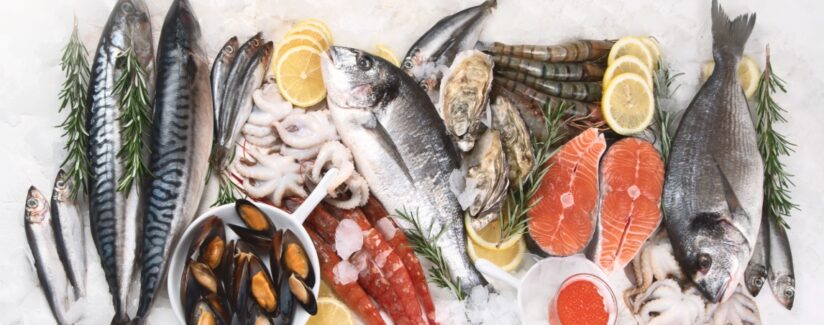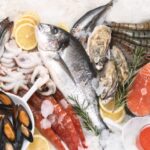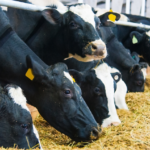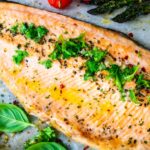
Are Farm-Raised Fish and Seafood Safe to Eat?
Food safety is a top priority for food buyers and producers.
Best Food Facts has been taking a deep dive into aquaculture, asking experts how fish are raised on farms and if these farm-raised fish and seafood are safe to eat. We talked to Dr. Jonathan van Senten, assistant professor and Extension specialist in aquaculture economics and marketing at Virginia Tech University; Myron Kebus, DVM, assistant professor and aquaculture outreach veterinarian at Michigan State University; and Dr. Katheryn Parraga-Estrada, Extension Specialist in Muscle Food Safety at Virginia Tech University.
What types of fish are most commonly raised in aquaculture?
Dr. van Senten: Globally, aquaculture production accounts for 51% of combined fisheries and aquaculture; with 62% of aquaculture production being done in inland waters. Finfish accounts for almost 90% of global inland aquaculture production.
- Carps account for more than half of global finfish production, followed by catfishes, cichlids and salmon types.
- Oysters account for about 37% of global mollusk production, followed by clams, scallops and mussels.
- In the United States, catfish, trout, and tilapia account for the largest sectors of finfish production.
What do fish on farms eat?
Dr. van Senten: Generally, the fish eat commercial diets that have been formulated specifically for that species of fish to ensure proper nutrition, health and growth. The exact makeup of the diets will vary based on the species of fish, since they have different requirements. Diets will incorporate other agricultural products, as is common in livestock farming. Fish meal and fish oil from reduction fisheries are an important part of the diet for some, but not all, species of fish. Over time, there has been a steady reduction in the inclusion of fishmeal and fish oil in commercial fish diets, as our knowledge of nutritional requirements for species improves and we are able to find suitable alternatives. It is important to note that not all forms of aquaculture are given feed; for example, mollusk aquaculture relies entirely on the natural productivity of the water in which they are grown and there is no addition of any feed to the culture system.
Learn more about soy in the fish diet from this video.
What do farmers and veterinarians do to promote the health of fish on farms?
Dr. Kebus: Fish farmers and veterinarians do many things, such as routine veterinary fish health assessments, routine testing for specific pathogens, water quality testing, and monitoring and investigating any abnormal increase in mortality.
What type of veterinary care do fish receive, such as antibiotics or medicine?
Dr. van Senten: In the U.S., there are stringent requirements regarding fish health and disease testing for aquaculture. For example, fish are required to be tested for health before being transported from one state to another. Requirements may also exist for testing fish being transported within the boundaries of a given state from one area to another (the exact nature of this varies from state to state). There are also legal requirements for the reporting of disease outbreaks on fish farms and specific pathogens of concern that are monitored by states and the federal government. Sampling and testing of fish health must be performed by a licensed and accredited veterinarian or fish pathologist.
Because prevention is better than treatment, many farms have implemented biosecurity measures to prevent disease on the farm. In the event of a disease outbreak, fish do receive veterinary care. One of the challenges is that there are few approved medicinal drugs for use in fish, which makes efforts aimed at preventing disease outbreaks all the more important.
Dr. Kebus: The Food and Drug Administration regulates the use of drugs in fish. If antibiotics are incorporated into feed, they can only be legally used in food fish under a Veterinary Feed Directive. The antibiotics have a withdrawal period in which residues may be detected in the fish. After the withdrawal period, it has been scientifically determined by the FDA that the antibiotic is not present to any level that presents a human safety concern.
Are farmed-raise fish safe to eat?
Dr. Parraga-Estrada: Farm-raised and wild-caught fish are safe to eat. In the U.S., the FDA oversees and inspects seafood facilities based on the Seafood HACCP regulation, which ensures that farm-raised fish have good aquaculture practices. For example, if a farm uses medications, then HACCP will regulate the drug usage and withdrawal periods. This ensures that the final product is safe for the consumer.
Are farmed fish contaminated with mercury or harmful chemicals? How does this compare with wild-caught fish?
Dr. Parraga-Estrada: Farmed fish are usually grown in a controlled environment, either in ponds or in pens in the ocean. Most of the time, farmed fish are fed specific diets that are similar to wild-caught fish that feed on other species. The concern with mercury is with big fish (such as sharks, tuna and swordfish) that are wild caught, as they consume prey that might contain mercury and mercury levels can accumulate more due to their size. The FDA has a specific chart with choices low in mercury and the recommended serving sizes based on that information.
How can you be sure fish and seafood are safe to consume?
Dr. Parraga-Estrada: Most companies that process, handle, and prepare seafood for wholesale or retail are inspected by the FDA and local or state regulatory agencies. This ensures that seafood is processed following current good manufacturing practices, food code regulations, or Seafood HACCP, resulting in a wholesome product for the consumer.
It is important that the final consumer also participates in keeping the product safe. Seafood is a highly perishable product; if a consumer buys fresh fish/seafood on a summer day with temperatures above 90°F and then runs errands without having an ice chest with ice to transport the seafood product, the product might lose quality, and the safety could be compromised. Key points to check when buying seafood are:
Fish
- Eyes-bright, clear and full
- Gills – bright red and pink
- Skin – shiny with tightly adhering scales
- Flesh – firm yet elastic
Shellfish
- Raw shrimp
- Meat firm with a mild odor
- Shells-translucent, grayish, green tint
- Not blackened or black spots
- Live clams
- Shells-tightly closed
- Live crabs
- Legs show movements
What food safety steps should be observed when preparing fish?
Dr. Parraga-Estrada: When preparing fish, it is important to read the package instructions and cook to an internal temperature (in the thickest part) of 145°F for at least 15 seconds. If preparing a dish that contains a raw seafood ingredient or is partially cooked, do not offer it to high-risk populations (children, pregnant women, elderly, and immunocompromised people).
What do you wish more people understood about fish farming?
Dr. van Senten: Fish farming is already providing half of the seafood consumed around the world today, and it is one of the ways that we will continue to provide nutritious healthy food for future generations. Aquaculture is an important option when we think about climate smart solutions for human food security.
Is Aquaculture a Sustainable Way to Produce Fish and Seafood?
How Does Aquaculture Affect Water Supplies?
Are Farm-Raised Fish as Nutritious as Wild-Caught Fish?
You can also join Best Food Facts as we tour four U.S. fish and seafood farms with two food bloggers.
This content is sponsored by BestFoodFacts.org and United Soybean Board.



























